Kelly Jensen's Blog, page 83
June 20, 2015
Giveaway: Sarah McCarry's "Metamophoses" series
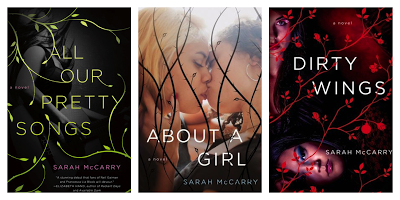
Kimberly and I are about to announce a bit of a blogging vacation. This will mean that we won't be posting anything new for a while -- but we'll get to that next week in more detail.
Because of that, we won't be talking about July releases immediately. This is okay, as July is generally a very slow month in publishing. Few titles are released, so we don't feel we'll be doing a huge disservice not highlighting them as soon as we can.
That said, one book hitting shelves in July is really important, really good, and one I absolutely want to make sure I mention before we vacation. It's the third book in Sarah McCarry's very loose "Metamophoses" series, About A Girl. This book features, like the rest of the series, a diverse cast in terms of ethnicity, race, and sexuality. It's got a killer, important, necessary cover to go along with it.
I've written about this series before, but each of the titles are related, building upon one another. They're takes on mythology, though familiarity with those myths isn't necessary. Neither is reading the books in order, though readers who do will see not only the growth of a writer, but the growth of a series of interconnected, fascinating, enveloping, lush worlds.
These are books that are perfect for readers who love fantasy, mythology, or books by authors like Francesca Lia Block or Nova Ren Suma. They're rich stories with rich, fully-fleshed characters. Readers who like literary fiction -- especially the kind that doesn't "feel" like YA but adult fiction -- will eat this series up.
To celebrate the release of About A Girl and to encourage more people to pick up this fantastic series, I'm giving away a complete set of "Metamophoses" books. You'll get All Our Pretty Songs, which was a YALSA pick for the Outstanding Books for the College Bound title, Dirty Wings, and About A Girl. I'll pull a winner around July 15, and this give away is open to US and Canadian residents.
Good luck!
I don't know whether I need to make a disclosure or not, but Sarah has become a friend over the last couple of years, is a contributor to Book Riot where I work, and she will be contributing an essay to my Feminism for the Real World anthology (hey, there's your first spoiler at who is involved!). I won't be writing a review of About A Girl for these reasons, but my enthusiasm for the series and the book are real and authentic. I want more people to read them.
Loading...







 Related StoriesGiveaway: Every Last Word by Tamara Ireland Stone + $25 Visa GiftcardCircuses Redux (plus giveaway!)All The Rage by Courtney Summers: Blog Tour and Giveaway
Related StoriesGiveaway: Every Last Word by Tamara Ireland Stone + $25 Visa GiftcardCircuses Redux (plus giveaway!)All The Rage by Courtney Summers: Blog Tour and Giveaway
Published on June 20, 2015 08:08
June 17, 2015
Hardcover to Paperback Makeovers: 5 Changes To Consider
How about another round of books getting new looks in their paperback editions? I've been letting these pile up in a draft post and I'm ready to talk about a handful of them now; I'll talk about some more soon since I've got a ton.
Let's take a look at five of them this time -- some of which are great makeovers and some which aren't maybe as solid as their initial look in hardcover. Which do you think does it better? Have you seen other recent changes you'd love to talk about?
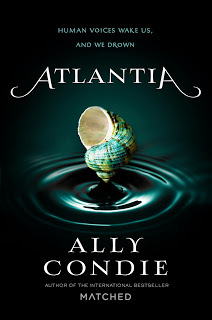
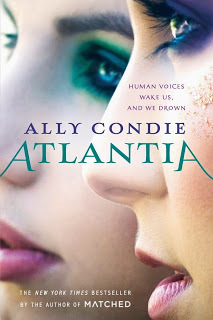
Ally Condie's Atlantia is getting a pretty dramatic makeover in paperback. Where it looks like an adult science fiction title in its hardcover edition on the left, the change in paperback looks a lot more like a generic YA novel geared toward teen readers on the right. The paperback tells the readers almost nothing -- it could be a book in any genre, since it's nothing more than a big face. The tag line, which is repeated from the hardcover, doesn't give much insight, either.
While I think there's maybe more teen appeal on the paperback, I think that's at the expense of being distinct and memorable. Also sort of interesting is that the author name seems to have shrunk in the new edition. Where it took up two lines and was more prominent than the title on the hardback, it's gotten smaller on the paperback and the title has sized up.
The hardcover is a stronger image on this one and wins for me. The paperback edition will be available October 20.
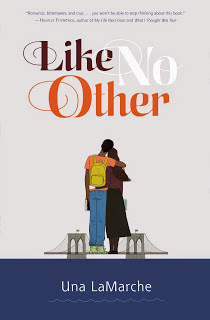
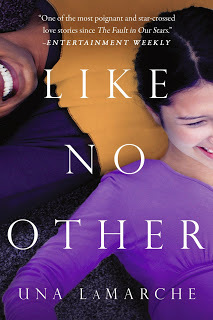
The original look for Una LaMarche's Like No Other followed in the tradition that began with Eleanor and Park -- an illustration depicting two teens who clearly have some sort of romantic relationship with one another. It's a cover trend I've never been fond of, since I think illustrated covers like this tend to not only tell you too much as a reader, but more, they actually begin blending together after a while (imagine someone asking for the book that's got an image of a couple that's illustrated -- you could probably name a pile of them that all came out around the same time). I also think they tend to look a little young. Which isn't to say I hate all illustrated covers, but rather, I dislike the ones that look like they're modeling a trend. More, this one bothers me since it's a story with people of color at the center and we don't get to see them face first. We just get their backs.
The paperback for this one is a winner, though. While I'm not wild about the models' faces being cut off, the fact we have their faces facing the readers is noteworthy. These are two people of color, and seeing that on a book, especially with the implication that they're in some sort of relationship in the story and aren't the same race, is important. This is a book you face out on a shelf because you know that readers are not only looking for these books, but readers are going to instantly identify with these faces.
However, because we can't skip a beat with following in the footsteps of trends, I find the pull quote on the paperback unnecessarily distracting. Any comps to The Fault in our Stars at this point feel like they're a real reach, and while I get it's an EW review, I think the fact that it's called "one of the best" since a book published in 2012 really undermines so many other books at the expense of the one it's featured on. I much prefer the blurb as featured on the hardcover.
Though frankly, you could ditch the quote all together on the paperback and use just the title and image to sell the hell out of it. This is a book that has a nice look that will appeal to teen AND adult readers easily.
Like No Other will be available in paperback on July 14.
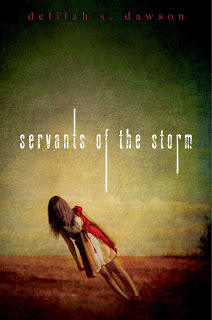
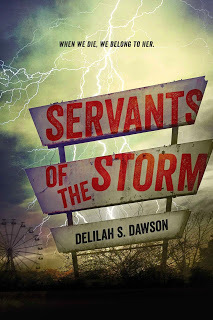
I've got complicated feelings on the cover remake of Delilah S. Dawson's Servants of the Storm, and it's not because I dislike either of the covers. I think they're both pretty great for depicting a horror story that follows in Gothic traditions. They have similar color schemes; the difference is primarily that they feature a different central image. The hardcover uses a girl who looks creepy, while the paperback makes use of a sign, a storm, and what is probably a not-too-happy carnival in the background.
The paperback's biggest difference in terms of the feel it gives off is through the tagline: "When we die, we belong to her." Imagine that on the hardcover. THAT, I think, would offer up a different feel with that cover and be more effective. On the paperback, who does the "her" refer to? There's not a person on the cover, and thus, there's not a lot of intrigue in terms of who we're supposed to be fearing. If the tagline were pulled off the paperback, it would be more effective, as there's a lot of feeling in the image alone that isn't necessarily contradicted by the tagline.
I'm not sure one of these covers is better than the other. Both are actually pretty intriguing and would appeal to the same type of reader.
Servants of the Storm hit shelves in paperback on June 2.
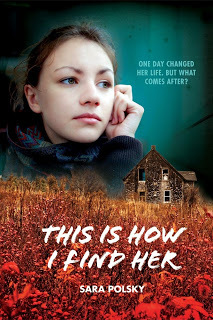
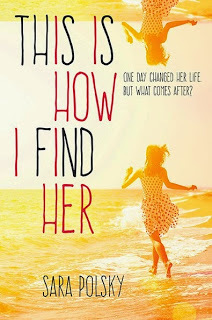
The redesign for Sara Polsky's This is How I Find Her might be one of the most dramatic in terms of the feeling it gives off that I have seen in a long time. The hardcover on the left has, since I initially saw it, made me immediately think of an Amish story. I don't think that's the intent, as this is a story about a girl dealing with her mother's bipolar disorder and suicide attempts. The hardcover, aside from that, does give off a more somber feel than its redesigned paperback on the right.
I'm having a hard time understanding the paperback. This looks like a lighthearted beach read, complete with a repeat of the tagline from the hardcover but in a context that makes it sound like a summer love, as opposed to dealing with a family challenge. More, I'm not sure I understand the font choice (I dislike the font here, period) and the decision to make the "I"s and "How" and "Her" pink, leaving the rest black. Is there something symbolic in it? Am I supposed to read another word in there? I am confused, rather than intrigued.
Neither of these covers tells me anything about the story and neither is particularly appealing or memorable to me, except for how they don't work. The hardcover might appeal more to older readers, whereas the paperback looks like it might reach younger readers more readily...even though it doesn't exactly get to the heart of the story.
The paperback edition of This is How I Find Her hit shelves on May 1.
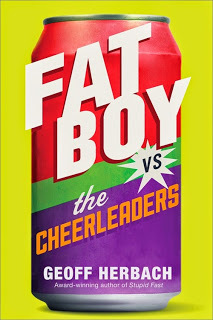
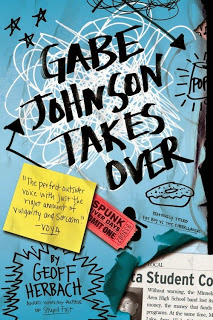
I saved the biggest change to talk about last because there's so much to talk about with this one. The book on the left is Fat Boy vs. The Cheerleaders, a standalone novel that came out from Geoff Herbach last year. I love this cover for so many reasons; it's bright, it's different, and the can is representative of the story and actually plays a role in it. This cover is memorable and stands out on a shelf.
The title, though. While it's accurate -- this is a story about Gabe, a fat boy, and it's about the things that happen to him in a turf war at school -- it's also sort of a turn-off. It generalizes the characters and creates a strange stereotyping of characters in high school. Since there's not a lot to go off in terms of the story's feel from the cover, even though it's a good one, that title becomes the anchor for readers in terms of what the book will be about. And the title isn't telling them a whole lot (or maybe it's telling them everything and that's not great, either).
The paperback makeover for this book means not only a facelift, but it received a title change, too. Rather than being Fat Boy vs. The Cheerleaders in paperback, it became Gabe Johnson Takes Over, which is a title that is so much better, more engaging, and less reliant upon stereotypes, which really are not at the heart of the story itself. The cover itself is fun, looking like a defaced school notebook, along with ephemera that is relevant to the story. The pop can hasn't disappeared, though it's taken a backseat. In many ways, this is a much more generic cover, but it's not generic in the way you'd forget about it, like a large image of a girl's face is. Where I usually don't love when a review or blurb from a review is used on a cover, it works here. Part of why it works is that this book really got lost in the shuffle and because the title changed, this signals to readers that it's a book that's earned recognition before. It's clearly not brand new or fighting for a spot. It's instead working toward reaching its audience better.
What I like about this makeover, too, is that the cover doesn't hide that it had a different original title. This is a useful tool for not just readers who may have picked up the book before, but it's extremely useful for those who will wonder whether it's a book they've purchased for a collection before.
While I'm sad that the cover isn't the pop can anymore, I think the makeover, both the title and the image itself, does a huge service for this book. The paperback of Gabe Johnson Takes Over is available now.







 Related StoriesColor Me Purple: YA Covers Featuring Shades of Plum2015 YA Book Cover Trends: Part II2015 YA Book Cover Trends: Part I
Related StoriesColor Me Purple: YA Covers Featuring Shades of Plum2015 YA Book Cover Trends: Part II2015 YA Book Cover Trends: Part I
Let's take a look at five of them this time -- some of which are great makeovers and some which aren't maybe as solid as their initial look in hardcover. Which do you think does it better? Have you seen other recent changes you'd love to talk about?


Ally Condie's Atlantia is getting a pretty dramatic makeover in paperback. Where it looks like an adult science fiction title in its hardcover edition on the left, the change in paperback looks a lot more like a generic YA novel geared toward teen readers on the right. The paperback tells the readers almost nothing -- it could be a book in any genre, since it's nothing more than a big face. The tag line, which is repeated from the hardcover, doesn't give much insight, either.
While I think there's maybe more teen appeal on the paperback, I think that's at the expense of being distinct and memorable. Also sort of interesting is that the author name seems to have shrunk in the new edition. Where it took up two lines and was more prominent than the title on the hardback, it's gotten smaller on the paperback and the title has sized up.
The hardcover is a stronger image on this one and wins for me. The paperback edition will be available October 20.


The original look for Una LaMarche's Like No Other followed in the tradition that began with Eleanor and Park -- an illustration depicting two teens who clearly have some sort of romantic relationship with one another. It's a cover trend I've never been fond of, since I think illustrated covers like this tend to not only tell you too much as a reader, but more, they actually begin blending together after a while (imagine someone asking for the book that's got an image of a couple that's illustrated -- you could probably name a pile of them that all came out around the same time). I also think they tend to look a little young. Which isn't to say I hate all illustrated covers, but rather, I dislike the ones that look like they're modeling a trend. More, this one bothers me since it's a story with people of color at the center and we don't get to see them face first. We just get their backs.
The paperback for this one is a winner, though. While I'm not wild about the models' faces being cut off, the fact we have their faces facing the readers is noteworthy. These are two people of color, and seeing that on a book, especially with the implication that they're in some sort of relationship in the story and aren't the same race, is important. This is a book you face out on a shelf because you know that readers are not only looking for these books, but readers are going to instantly identify with these faces.
However, because we can't skip a beat with following in the footsteps of trends, I find the pull quote on the paperback unnecessarily distracting. Any comps to The Fault in our Stars at this point feel like they're a real reach, and while I get it's an EW review, I think the fact that it's called "one of the best" since a book published in 2012 really undermines so many other books at the expense of the one it's featured on. I much prefer the blurb as featured on the hardcover.
Though frankly, you could ditch the quote all together on the paperback and use just the title and image to sell the hell out of it. This is a book that has a nice look that will appeal to teen AND adult readers easily.
Like No Other will be available in paperback on July 14.


I've got complicated feelings on the cover remake of Delilah S. Dawson's Servants of the Storm, and it's not because I dislike either of the covers. I think they're both pretty great for depicting a horror story that follows in Gothic traditions. They have similar color schemes; the difference is primarily that they feature a different central image. The hardcover uses a girl who looks creepy, while the paperback makes use of a sign, a storm, and what is probably a not-too-happy carnival in the background.
The paperback's biggest difference in terms of the feel it gives off is through the tagline: "When we die, we belong to her." Imagine that on the hardcover. THAT, I think, would offer up a different feel with that cover and be more effective. On the paperback, who does the "her" refer to? There's not a person on the cover, and thus, there's not a lot of intrigue in terms of who we're supposed to be fearing. If the tagline were pulled off the paperback, it would be more effective, as there's a lot of feeling in the image alone that isn't necessarily contradicted by the tagline.
I'm not sure one of these covers is better than the other. Both are actually pretty intriguing and would appeal to the same type of reader.
Servants of the Storm hit shelves in paperback on June 2.


The redesign for Sara Polsky's This is How I Find Her might be one of the most dramatic in terms of the feeling it gives off that I have seen in a long time. The hardcover on the left has, since I initially saw it, made me immediately think of an Amish story. I don't think that's the intent, as this is a story about a girl dealing with her mother's bipolar disorder and suicide attempts. The hardcover, aside from that, does give off a more somber feel than its redesigned paperback on the right.
I'm having a hard time understanding the paperback. This looks like a lighthearted beach read, complete with a repeat of the tagline from the hardcover but in a context that makes it sound like a summer love, as opposed to dealing with a family challenge. More, I'm not sure I understand the font choice (I dislike the font here, period) and the decision to make the "I"s and "How" and "Her" pink, leaving the rest black. Is there something symbolic in it? Am I supposed to read another word in there? I am confused, rather than intrigued.
Neither of these covers tells me anything about the story and neither is particularly appealing or memorable to me, except for how they don't work. The hardcover might appeal more to older readers, whereas the paperback looks like it might reach younger readers more readily...even though it doesn't exactly get to the heart of the story.
The paperback edition of This is How I Find Her hit shelves on May 1.


I saved the biggest change to talk about last because there's so much to talk about with this one. The book on the left is Fat Boy vs. The Cheerleaders, a standalone novel that came out from Geoff Herbach last year. I love this cover for so many reasons; it's bright, it's different, and the can is representative of the story and actually plays a role in it. This cover is memorable and stands out on a shelf.
The title, though. While it's accurate -- this is a story about Gabe, a fat boy, and it's about the things that happen to him in a turf war at school -- it's also sort of a turn-off. It generalizes the characters and creates a strange stereotyping of characters in high school. Since there's not a lot to go off in terms of the story's feel from the cover, even though it's a good one, that title becomes the anchor for readers in terms of what the book will be about. And the title isn't telling them a whole lot (or maybe it's telling them everything and that's not great, either).
The paperback makeover for this book means not only a facelift, but it received a title change, too. Rather than being Fat Boy vs. The Cheerleaders in paperback, it became Gabe Johnson Takes Over, which is a title that is so much better, more engaging, and less reliant upon stereotypes, which really are not at the heart of the story itself. The cover itself is fun, looking like a defaced school notebook, along with ephemera that is relevant to the story. The pop can hasn't disappeared, though it's taken a backseat. In many ways, this is a much more generic cover, but it's not generic in the way you'd forget about it, like a large image of a girl's face is. Where I usually don't love when a review or blurb from a review is used on a cover, it works here. Part of why it works is that this book really got lost in the shuffle and because the title changed, this signals to readers that it's a book that's earned recognition before. It's clearly not brand new or fighting for a spot. It's instead working toward reaching its audience better.
What I like about this makeover, too, is that the cover doesn't hide that it had a different original title. This is a useful tool for not just readers who may have picked up the book before, but it's extremely useful for those who will wonder whether it's a book they've purchased for a collection before.
While I'm sad that the cover isn't the pop can anymore, I think the makeover, both the title and the image itself, does a huge service for this book. The paperback of Gabe Johnson Takes Over is available now.







 Related StoriesColor Me Purple: YA Covers Featuring Shades of Plum2015 YA Book Cover Trends: Part II2015 YA Book Cover Trends: Part I
Related StoriesColor Me Purple: YA Covers Featuring Shades of Plum2015 YA Book Cover Trends: Part II2015 YA Book Cover Trends: Part I
Published on June 17, 2015 22:00
June 16, 2015
Read by the Author
Authors who narrate their own books produce audiobooks of mixed quality, in my experience. Often authors who read their own memoirs or autobiographies have more success than authors who read their novels (presumably because they lived the words and therefore feel them more authentically), but even then, I've run across some real duds. Some authors just aren't meant to be narrators.
During Cybils season last year, I listened to a lot of audiobooks as part of my strategy to read as many nominees as possible. One such book was Night Sky by Suzanne and Melanie Brockmann (who narrated). The book itself was just OK, but it could have been elevated by some truly excellent narration. Unfortunately, Melanie Brockmann isn't really up to the task. Her narration isn't terrible, but it has enough negatives to impinge on the listening experience - she sounds like she runs out of air a lot (probably not helped by the really long sentences), and she doesn't voice any of the characters at all. Sometimes voicing can negatively impact an audiobook when it's done poorly, but here it was just confusing and pretty dull.
There are a few novels read by their authors that I've really enjoyed, though. Sherman Alexie's narration of The Absolutely True Diary of a Part-Time Indian is so good that I didn't even miss the illustrations, and Neil Gaiman has a voice made for narration. I also really love Philip Pullman's treatment of The Golden Compass and its sequels for Full Cast Audio. He provides the general narration while a full cast of other readers provide the dialogue. His calm, even voice is a perfect backdrop for the more energetic characters performed by others.
When it comes to nonfiction, I've really enjoyed David Sedaris' works, though it took me a while to warm up to his style of narration. He's quite dry and it doesn't always seem like he's telling a joke - though of course he is. Now I can't imagine listening to his books read by anyone else. Stephen King's On Writing is also an exceptional example of nonfiction read by the author (though Stephen King's writing is so good, I'm not sure even a bad narrator could ruin the experience completely).
Audiobook lovers - what has been your experience with books read by their authors? Are you a fan?






 Related StoriesAudio Review: Under the Banner of Heaven by Jon KrakauerA Memoir, a Novel, and a Graphic NovelA Pair of Audiobook Reviews
Related StoriesAudio Review: Under the Banner of Heaven by Jon KrakauerA Memoir, a Novel, and a Graphic NovelA Pair of Audiobook Reviews
During Cybils season last year, I listened to a lot of audiobooks as part of my strategy to read as many nominees as possible. One such book was Night Sky by Suzanne and Melanie Brockmann (who narrated). The book itself was just OK, but it could have been elevated by some truly excellent narration. Unfortunately, Melanie Brockmann isn't really up to the task. Her narration isn't terrible, but it has enough negatives to impinge on the listening experience - she sounds like she runs out of air a lot (probably not helped by the really long sentences), and she doesn't voice any of the characters at all. Sometimes voicing can negatively impact an audiobook when it's done poorly, but here it was just confusing and pretty dull.
There are a few novels read by their authors that I've really enjoyed, though. Sherman Alexie's narration of The Absolutely True Diary of a Part-Time Indian is so good that I didn't even miss the illustrations, and Neil Gaiman has a voice made for narration. I also really love Philip Pullman's treatment of The Golden Compass and its sequels for Full Cast Audio. He provides the general narration while a full cast of other readers provide the dialogue. His calm, even voice is a perfect backdrop for the more energetic characters performed by others.
When it comes to nonfiction, I've really enjoyed David Sedaris' works, though it took me a while to warm up to his style of narration. He's quite dry and it doesn't always seem like he's telling a joke - though of course he is. Now I can't imagine listening to his books read by anyone else. Stephen King's On Writing is also an exceptional example of nonfiction read by the author (though Stephen King's writing is so good, I'm not sure even a bad narrator could ruin the experience completely).
Audiobook lovers - what has been your experience with books read by their authors? Are you a fan?







 Related StoriesAudio Review: Under the Banner of Heaven by Jon KrakauerA Memoir, a Novel, and a Graphic NovelA Pair of Audiobook Reviews
Related StoriesAudio Review: Under the Banner of Heaven by Jon KrakauerA Memoir, a Novel, and a Graphic NovelA Pair of Audiobook Reviews
Published on June 16, 2015 22:00
June 15, 2015
How Do You Organize Your Books? (Follow-Up)
Thanks to all who answered my informal poll about organization of your personal books! I thought the results were pretty interesting, if unscientific. Because we're clearly all nerds, I thought you'd appreciate seeing the results in graph format. I've also shared some of the more interesting "Other" responses below.
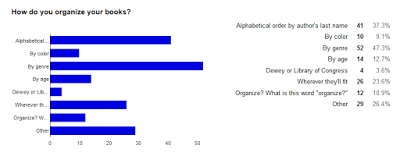 Click on the graph to make it larger.
Click on the graph to make it larger.
A total of 111 people responded, and most of you selected more than one option, which I assumed would be the case. Leading the pack is "by genre" with 52 responses, which was pretty surprising to me as it's never something I've done before (though I've always wanted to). I also think it's interesting since it seems like genre separation is something public libraries are moving away from. People clearly think it's important for their personal collections, though.
In second place was "alphabetical order by author's last name" with 41 responses. This one doesn't surprise me at all. It's a really easy organizational scheme both to set up and to use for locating titles afterward. On the opposite end, almost no one organizes their books by Dewey or Library of Congress. Either this means our readers don't have much nonfiction (I realize fiction can be classified this way too, but that's just silly - I'm looking at you, academic libraries), or these classification schemes just aren't that easy. Or both. (I'm in the both camp.)
If I combine "wherever they'll fit" and "organize? What is this word organize?" into one category, it comes in third place with 38 responses. These people seem to be in the same situation I have been in for the past several years: limited space means books just get shoved where they can fit, and organization is not as important as making sure the books don't get stored in, say, the oven.
The "other" responses were the most interesting. Many of you wrote that you organize by size, which is something I should have included in the original poll. It's something I do, too, without really realizing it. For example, I keep all my mass markets separate from my hardbacks (which is something I'll probably continue to do in the new house). Many of you mentioned space as a factor, and a few mentioned giving away lots of books due to space or just not feeling the need to keep something you won't read again.
Here are a few of my favorite "other" responses, with my own comments in italics:I have a shelf dedicated just to books I haven't read yet. (I had this at my old place where we had a ton of built-ins, but in my current place, the books I haven't read tend to just sit on tables.)My other shelf is for books I've read and LOVED.By books I've read and books that are unread and then by genre. (An organizational scheme after my own heart. Perhaps something I'll do in my new place.)Importance Personal interest By imprint (all NYRB together, all Penguin black spines together, etc) (By far one of the nerdiest responses, and I mean that lovingly.)If they were purchased for a class, they tend to stay with their "classmates."Release date then author's last name Loosely by genre-- for example, British mysteries are separate from cozy mysteries, etc, but I do keep series together.By "themes" and by favourites vs. non-favourites. (Organizing by favorites was a popular reply.)Crammed into boxes by size. I only have space to have out books I am actively reading. Very unhappy. (This would make me unhappy too.)Stream of consciousnessAlphabetical and then by publishing date except for series... it's complicated.Genre first, then beauty (series are kept together, no matter what).There were a lot of great, more in-depth comments on the original post, too, so be sure to check it out if this topic interests you.






 Related StoriesHow Do You Organize Your Books?Getting Things Done with Bullet Journaling
Related StoriesHow Do You Organize Your Books?Getting Things Done with Bullet Journaling
 Click on the graph to make it larger.
Click on the graph to make it larger.A total of 111 people responded, and most of you selected more than one option, which I assumed would be the case. Leading the pack is "by genre" with 52 responses, which was pretty surprising to me as it's never something I've done before (though I've always wanted to). I also think it's interesting since it seems like genre separation is something public libraries are moving away from. People clearly think it's important for their personal collections, though.
In second place was "alphabetical order by author's last name" with 41 responses. This one doesn't surprise me at all. It's a really easy organizational scheme both to set up and to use for locating titles afterward. On the opposite end, almost no one organizes their books by Dewey or Library of Congress. Either this means our readers don't have much nonfiction (I realize fiction can be classified this way too, but that's just silly - I'm looking at you, academic libraries), or these classification schemes just aren't that easy. Or both. (I'm in the both camp.)
If I combine "wherever they'll fit" and "organize? What is this word organize?" into one category, it comes in third place with 38 responses. These people seem to be in the same situation I have been in for the past several years: limited space means books just get shoved where they can fit, and organization is not as important as making sure the books don't get stored in, say, the oven.
The "other" responses were the most interesting. Many of you wrote that you organize by size, which is something I should have included in the original poll. It's something I do, too, without really realizing it. For example, I keep all my mass markets separate from my hardbacks (which is something I'll probably continue to do in the new house). Many of you mentioned space as a factor, and a few mentioned giving away lots of books due to space or just not feeling the need to keep something you won't read again.
Here are a few of my favorite "other" responses, with my own comments in italics:I have a shelf dedicated just to books I haven't read yet. (I had this at my old place where we had a ton of built-ins, but in my current place, the books I haven't read tend to just sit on tables.)My other shelf is for books I've read and LOVED.By books I've read and books that are unread and then by genre. (An organizational scheme after my own heart. Perhaps something I'll do in my new place.)Importance Personal interest By imprint (all NYRB together, all Penguin black spines together, etc) (By far one of the nerdiest responses, and I mean that lovingly.)If they were purchased for a class, they tend to stay with their "classmates."Release date then author's last name Loosely by genre-- for example, British mysteries are separate from cozy mysteries, etc, but I do keep series together.By "themes" and by favourites vs. non-favourites. (Organizing by favorites was a popular reply.)Crammed into boxes by size. I only have space to have out books I am actively reading. Very unhappy. (This would make me unhappy too.)Stream of consciousnessAlphabetical and then by publishing date except for series... it's complicated.Genre first, then beauty (series are kept together, no matter what).There were a lot of great, more in-depth comments on the original post, too, so be sure to check it out if this topic interests you.







 Related StoriesHow Do You Organize Your Books?Getting Things Done with Bullet Journaling
Related StoriesHow Do You Organize Your Books?Getting Things Done with Bullet Journaling
Published on June 15, 2015 22:00
June 14, 2015
June Debut YA Novels
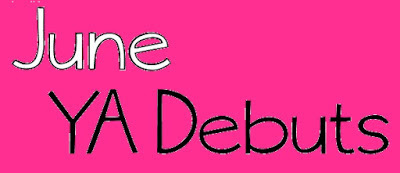
It's time for another round-up of debut YA novels of the month.
Like always, this round-up includes debut novels, where "debut" is in its purest definition. These are first-time books by first-time authors. I'm not including books by authors who are using or have used a pseudonym in the past or those who have written in other categories (adult, middle grade, etc.) in the past.
All descriptions are from WorldCat, unless otherwise noted. If I'm missing any debuts out in June from traditional publishers, let me know in the comments. As always, not all noted titles included here are necessarily endorsements for those titles.
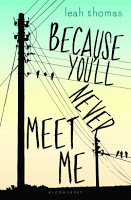
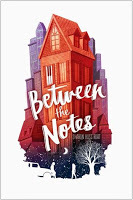
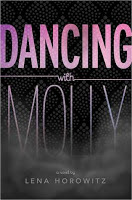
Because You'll Never Meet Me by Leah Thomas: Ollie and Moritz are best friends, but they can never meet. Ollie is allergic to electricity. Contact with it causes debilitating seizures. Moritz's weak heart is kept pumping by an electronic pacemaker. If they ever did meet, Ollie would seize. But Moritz would die without his pacemaker. Both hermits from society, the boys develop a fierce bond through letters that become a lifeline during dark times -- as Ollie loses his only friend, Liz, to the normalcy of high school and Moritz deals with a bully set on destroying him. A story of impossible friendship and hope under strange circumstances, about two special boys who, like many teens, are just waiting for their moment to shine.
Between The Notes by Sharon Huss Roat: When Ivy Emerson’s family loses their house—complete with her beloved piano—the fear of what’s to come seizes her like a bad case of stage fright. Only this isn’t one of her single, terrifying performances. It’s her life.
And it isn’t pretty.
Ivy is forced to move with her family out of their affluent neighborhood to Lakeside, also known as “the wrong side of the tracks.” Hiding the truth from her friends—and the cute new guy in school, who may have secrets of his own—seems like a good idea at first. But when a bad boy next door threatens to ruin everything, Ivy’s carefully crafted lies begin to unravel . . . and there is no way to stop them.
As things get to the breaking point, Ivy turns to her music, some unlikely new friends, and the trusting heart of her disabled little brother. She may be surprised that not everyone is who she thought they were, including herself. (via Goodreads).
Dancing with Molly by Lena Horowitz: High school junior Becca is just a "band geek" until when her friends introduce her to molly, a form of ecstasy, and she finds herself with new friends--even a boyfriend--but soon learns there is a price to her newfound popularity.
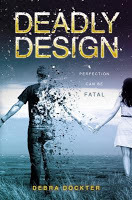
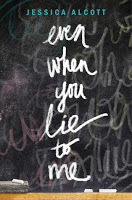
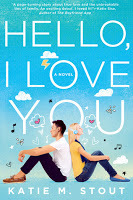
Deadly Design by Debra Dockter: Kyle McAdams races to find out what's killing kids conceived at the Genesis Innovations Laboratory before he becomes yet another perfect, blue-eyed corpse.
Even When You Lie to Me by Jessica Alcott: Because she sees herself as ugly and a misfit, tolerated only because of her friendship with pretty and popular Lila, Charlie dreads her senior year, but a crush on the new charismatic English teacher, Mr. Drummond, makes school bearable until her eighteenth birthday, when boundaries are crossed.
Hello, I Love You by Katie M. Stout: Grace Wilde is hoping for a fresh start from her family, famous in the music industry, and escapes to the farthest place from home she can think of, a boarding school in Korea, but when her roommate Sophie's twin brother Jason turns out to be the newest Korean pop music superstar, Grace is thrust back into the world of fame and love.
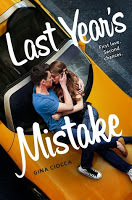
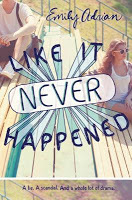
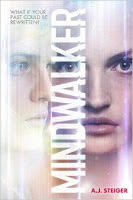
Last Year's Mistake by Gina Ciocca: Although Kelsey has fallen in love with her best friend, David, she cuts ties with him before moving from Connecticut to Rhode Island, believing they need a fresh start, but David moves nearby at the start of senior year, threatening Kelsey's relationship with Ryan.
Like It Never Happened by Emily Adrian: As one of The Essential Five theater students at her alternative high school, Rebecca Rivers is preparing to become an actress and enjoying junior year with the perfect boyfriend until life-changing rumors threaten everything.
Mindwalker by AJ Steiger: In a futuristic reality, one girl falls in love with the boy whose memories she tries to erase.
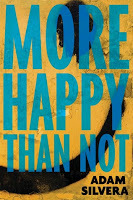
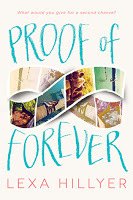
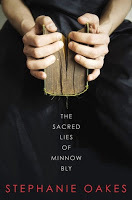
More Happy Than Not by Adam Silvera: After enduring his father's suicide, his own suicide attempt, broken friendships, and more in the Bronx projects, Aaron Soto, sixteen, is already considering the Leteo Institute's memory-alteration procedure when his new friendship with Thomas turns to unrequited love.
Proof of Forever by Lexa Hillyer: Four former friends are transported back in time to a pivotal summer in all of their lives during a camp reunion.
The Sacred Lies of Minnow Bly by Stephanie Oakes: A handless teen escapes from a cult, only to find herself in juvenile detention and suspected of knowing who murdered her cult leader.
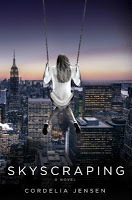
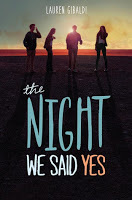
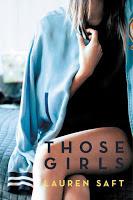
Skyscraping by Cordelia Jensen: In 1993 in New York City, high school senior Mira uncovers many secrets, including that her father has a male lover.
The Night We Said Yes by Lauren Gibraldi: Before Matt, Ella had a plan. Get over a no-good ex-boyfriend. Graduate from high school without any more distractions. Move away from Orlando, Florida, where she’s lived her entire life.
But Matt—the cute, shy, bespectacled bass player who just moved to town—was never part of that plan.
And neither was attending a party that was crashed by the cops just minutes after they arrived. Or spending an entire night saying “yes” to every crazy, fun thing they could think of.
Then Matt abruptly left town, and he broke not only Ella’s heart but those of their best friends, too. So when he shows up a year later with a plan of his own—to relive the night that brought them together—Ella isn’t sure whether Matt’s worth a second chance. Or if re-creating the past can help them create a different future. (via Goodreads).
Those Girls by Lauren Saft: Eleventh grade at Greencliff, an all-girl school near Philadelphia, is momentous for long-term best friends Alex, Mollie, and Veronica, as the secrets they are keeping from each other about boyfriends, eating disorders, and more begin to undermine their relationships.
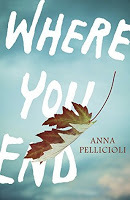
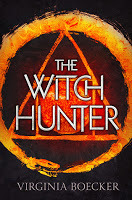
Where You End by Anna Pellicioli: Overwrought when she sees her ex-boyfriend with another girl during a class field trip, seventeen-year-old Miriam Feldman races into the Hirshhorn Sculpture Garden and pushes over a priceless Picasso sculpture, then finds herself blackmailed by the mystery girl who saw what she did.
The Witch Hunter by Virginia Boecker: Set in an alternative 16th-century England, Elizabeth Grey is the only girl in the king's elite group of witch hunters. When she's framed for being a witch herself, Elizabeth finds freedom at the hands of the world's most wanted wizard and her loyalties are tested.







 Related StoriesApril Debut YA NovelsMarch Debut YA NovelsFebruary Debut YA Novels
Related StoriesApril Debut YA NovelsMarch Debut YA NovelsFebruary Debut YA Novels
Published on June 14, 2015 22:00
June 13, 2015
Links of Note: June 14, 2015
It's been a long time since I've done a "This Week in Reading" post or a "Links of Note" post. Since I have been keeping so many of these links in Pocket for weeks (maybe months!), I thought it'd be worth a giant dump of them into a post. Most of these are book or reading related, but many aren't. They're things that have caught my eye or been interesting reads in their own right.
If you've read something interesting lately you think would be up my alley, which is pretty obvious from this collection, I'd love to hear about it in the comments.
First: here's a teaser for the upcoming YA Quarterly Box I am curating for Book Riot. I LOVE this box so much. I managed to get three books inside it, along with two bookish items, and there will be exclusive content from the authors, as well. This will be well worth your $50.
Did you know I'm working on a new project with librarians Faythe Arredondo, Hannah Gomez, and Angie Manfredi called Size Acceptance in YA? It's exactly what it sounds like.
John Scalzi's post on what he is and isn't obliged to comment or write about has been on my mind a lot lately. I've made significant changes in my social media lately, and I continue to think about these decisions. Scalzi hit on some of the things I've been mulling over here.
This piece at Rookie about body image and norms/standards/ideals of beauty is gutting and beautiful.
The role of black dolls in American culture left me thinking about Addy from American Girl in ways I never had before. I have a complicated relationship with American Girl dolls in general, since I was a kid who could never have one because they were too expensive, but I remember Addy being my favorite when she was introduced.
Cecil Castellucci talks about how anyone can be a good art ally.
This is a fantastic interview between Kristin Halbook and Courtney Summers about rape culture and YA lit. If you missed it, I had the opportunity to talk with Courtney alongside legendary Laurie Halse Anderson earlier this year on the topic of rape culture, girls' stories, and more at Book Riot. Easily, one of the most interesting and important things I've had the opportunity to do.
If you're an unagented YA writer, you should know about this contest Courtney Summers is having. You can win the chance for feedback from her agent on part of your manuscript.
Speaking of writers without agents or contracts, I'm a judge for this year's Elephant Rock Books Sheehan Prize. If you have a completed YA manuscript, you might want to enter this. The last winner of this prize was Jessie Ann Foley, who went on to earn a Printz and Morris honor.
I love this round-up of 84 films by and about women of color. "A Girl Walks Home Alone at Night" is one of the most enjoyable movies I've watched in a long time and features this scene which will never, EVER not be the best. This is a skateboarding vampire:

However you feel about Eleanor and Park -- and I've been pretty clear that I liked the book quite a lot! -- this master post about why it's problematic in terms of its racism is a must-read.
This post talking about the evolution of the cover of Me and Earl and The Dying Girl ticks all of my boxes: cover design, image evolution, and the feelings artists hope to create in a book cover. So, so good.
Did you know next weekend is the 48 Hour Book Challenge? I will be participating.
This year's Kid Lit Con information has been trickling in. It'll be October 9 and 10th in Baltimore, and you can register, pitch a panel topic, and more over here. I'm making plans to be there.
Feminist noir? Yes please.
This is a very, very tough read about mental illness, social media, and about how we can present one image to the world while struggling with something miserable inside. I think, though, this is important reading, especially for anyone who knows or struggles with mental illness themselves.
Teen feminists who are changing the world.
Finally, this piece about how horror movies are the one place where women are told their fears are real is SO good. I saw "It Follows" earlier this year, and this article sort of hit on why that movie really stuck with me and why it is I keep thinking about it. It's about fear, about the things that follow and haunt us, and about how society doesn't want to give credence to those very things that torment us.






 Related StoriesThis Week in Reading: Volume 12Links of Note: May 17, 2014Links of Note: May 3, 2014
Related StoriesThis Week in Reading: Volume 12Links of Note: May 17, 2014Links of Note: May 3, 2014
If you've read something interesting lately you think would be up my alley, which is pretty obvious from this collection, I'd love to hear about it in the comments.
First: here's a teaser for the upcoming YA Quarterly Box I am curating for Book Riot. I LOVE this box so much. I managed to get three books inside it, along with two bookish items, and there will be exclusive content from the authors, as well. This will be well worth your $50.
Did you know I'm working on a new project with librarians Faythe Arredondo, Hannah Gomez, and Angie Manfredi called Size Acceptance in YA? It's exactly what it sounds like.
John Scalzi's post on what he is and isn't obliged to comment or write about has been on my mind a lot lately. I've made significant changes in my social media lately, and I continue to think about these decisions. Scalzi hit on some of the things I've been mulling over here.
This piece at Rookie about body image and norms/standards/ideals of beauty is gutting and beautiful.
The role of black dolls in American culture left me thinking about Addy from American Girl in ways I never had before. I have a complicated relationship with American Girl dolls in general, since I was a kid who could never have one because they were too expensive, but I remember Addy being my favorite when she was introduced.
Cecil Castellucci talks about how anyone can be a good art ally.
This is a fantastic interview between Kristin Halbook and Courtney Summers about rape culture and YA lit. If you missed it, I had the opportunity to talk with Courtney alongside legendary Laurie Halse Anderson earlier this year on the topic of rape culture, girls' stories, and more at Book Riot. Easily, one of the most interesting and important things I've had the opportunity to do.
If you're an unagented YA writer, you should know about this contest Courtney Summers is having. You can win the chance for feedback from her agent on part of your manuscript.
Speaking of writers without agents or contracts, I'm a judge for this year's Elephant Rock Books Sheehan Prize. If you have a completed YA manuscript, you might want to enter this. The last winner of this prize was Jessie Ann Foley, who went on to earn a Printz and Morris honor.
I love this round-up of 84 films by and about women of color. "A Girl Walks Home Alone at Night" is one of the most enjoyable movies I've watched in a long time and features this scene which will never, EVER not be the best. This is a skateboarding vampire:

However you feel about Eleanor and Park -- and I've been pretty clear that I liked the book quite a lot! -- this master post about why it's problematic in terms of its racism is a must-read.
This post talking about the evolution of the cover of Me and Earl and The Dying Girl ticks all of my boxes: cover design, image evolution, and the feelings artists hope to create in a book cover. So, so good.
Did you know next weekend is the 48 Hour Book Challenge? I will be participating.
This year's Kid Lit Con information has been trickling in. It'll be October 9 and 10th in Baltimore, and you can register, pitch a panel topic, and more over here. I'm making plans to be there.
Feminist noir? Yes please.
This is a very, very tough read about mental illness, social media, and about how we can present one image to the world while struggling with something miserable inside. I think, though, this is important reading, especially for anyone who knows or struggles with mental illness themselves.
Teen feminists who are changing the world.
Finally, this piece about how horror movies are the one place where women are told their fears are real is SO good. I saw "It Follows" earlier this year, and this article sort of hit on why that movie really stuck with me and why it is I keep thinking about it. It's about fear, about the things that follow and haunt us, and about how society doesn't want to give credence to those very things that torment us.







 Related StoriesThis Week in Reading: Volume 12Links of Note: May 17, 2014Links of Note: May 3, 2014
Related StoriesThis Week in Reading: Volume 12Links of Note: May 17, 2014Links of Note: May 3, 2014
Published on June 13, 2015 22:00
June 12, 2015
This Week at Book Riot and Elsewhere
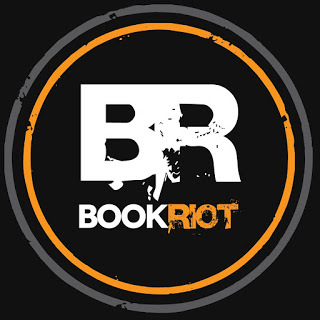
Over at Book Riot this week, I had two posts -- one that went up on Friday, which is why this post didn't hit until today:
I rounded-up a ton of cat-centric adult fiction. This post is paw-sitively packed with puns.
For 3 On A YA Theme, I talked about pets in YA fiction. All three examples happen to be dogs and one is a book that'll hit shelves this fall.
Earlier this week, I had the pleasure of being part of a webinar for the Massachusetts Library System with Liz Burns and Sophie Brookover. We talked about New Adult fiction, defining what it is, how it's grown, and some of the key titles. You can tune into the webinar and access our slides and reading guide right here for free.







 Related StoriesThis Week at Book RiotThis Week at Book Riot & Disability in Kid LitThis Week on Book Riot
Related StoriesThis Week at Book RiotThis Week at Book Riot & Disability in Kid LitThis Week on Book Riot
Published on June 12, 2015 22:00
June 10, 2015
Recent Reads: Immaculate by Katelyn Detweiler, Devoted by Jen Mathieu, and The Sacred Lies of Minnow Bly by Stephanie Oakes
I've read three really solid contemporary titles recently, and one of the really fascinating threads connecting them together, aside from strong, engaging lead females, is that they all deal with the idea of faith in some capacity. In one story, there's a very loose take on the Virgin Mary story; the second story tackles a girl's decision to leave the Quiverfull movement; and the third explores what happens when a girl decides that following the rules of the cult her family is a part of simply isn't her destiny.
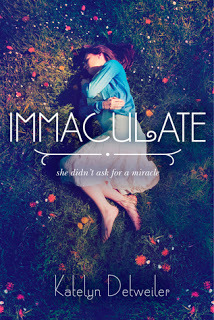 Immaculate by Katelyn Detweiler
Immaculate by Katelyn Detweiler
I've read almost no reviews of this debut title, which came out last month, and I'm sad about that. While the book's description lends itself to some immediate reactions -- a teen girl is pregnant, despite being a virgin -- this isn't at all a morality tale or a story with a heavy religious hand in it. Rather, this is a book about faith, both in oneself and more, faith in other people.
When Mina discovers she's pregnant following a very strange conversation with an old woman in the restaurant she works in, she doesn't know what to do. How does she explain to her parents, to her best friends, and to her boyfriend that she's pregnant, even though she's never had sex? As she begins to tell them one by one, we see the ways people react to her story. Is she worth believing? Why would a girl lie about having sex when there's clear-cut evidence that some sort of sexual intercourse happened resulting in a pregnancy?
This isn't entirely a Virgin Mary spin, though that's a bit of a jumping off point for Detweiler's novel. In fact, there's almost nothing about religion in here at all. It's a solid story about how we do and do not believe girls when they tell us something. At the heart of this book, and the thing that really stood out for me, was how much there was about friendship. Mina's two best friends have wildly different reactions to her pregnancy, and those divergent reactions are the heart of the idea of how we do and don't listen, how we do and don't believe, and how we do or don't choose to have faith in another human being.
Immaculate does have an almost too perfect romance in it, but because I found the story was much less about love, much less about the pregnancy, and much less about anything other than girls' stories, it didn't clog up the storytelling nor weigh down the overarching themes. Likewise, readers who go into this one expecting resolution or explanation for the pregnancy may be disappointed. However, that would be the point -- the faith you need to take in Mina and in Detweiler's story. This is a longer book, but it's fast-paced, the writing is solid, and the building of a small town scandal is executed well.
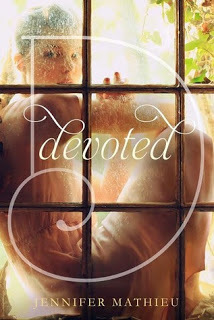
Devoted by Jennifer Mathieu
For her entire life, Rachel Walker has gone along with the beliefs of her large family, which is devoted to the teachings of the Calvary Christian Church. She's never questioned it before; she dresses modestly, takes on much of the care of her siblings, and she believes her role as a woman in life is to become a wife and a mother.
The story picks up when Rachel begins to question the teachings of her family and her church -- she becomes quickly intrigued by the story of a girl who had left the movement and began her own life. As Rachel begins to ask more questions about life outside of the church world, she's less and less satisfied by the answers she's given. So when she reaches out to the girl who left and finds herself wanting to know more and more and more, Rachel makes the decision to leave.
I devoured Mathieu's novel, reading the entire book in about one sitting. As a long time fan of the Duggars (and, so it's clear, one who stopped watching the show a while ago and finds the situation going on now to be entirely disgusting and unforgivable), I felt like Mathieu explored a part of the Quiverfull movement I've always been curious about. What happens if someone decides to leave? What could cause a person who'd been brought up in a very specific set of beliefs to want to consider other alternatives? Why do some people do this while the rest choose to stay?
Devoted isn't about a "bad girl" who chooses to flee. It's about a girl who is really good but is curious and wants to know the world beyond the bounds she's grown up in. Mathieu is exceptionally respectful to the Quiverfull movement, though she allows her characters to dig into why some of the beliefs are problematic and damaging, especially to young girls. It'd be really interesting for a reader to pick this one up now in light of the Duggar molestation knowledge; I read it beforehand, and I suspect had I waited to read it, the story would take on an even harder edge to it in light of the power of girls in social worlds such as this. Readers who loved Carol Lynch Williams's The Chosen One should pick this title up.
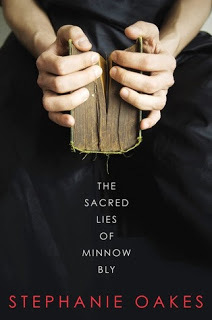 The Sacred Lies of Minnow Bly by Stephanie Oakes
The Sacred Lies of Minnow Bly by Stephanie Oakes
Minnow Bly's story begins bloody. She's murdered -- or at least attempted to murder -- someone from the closed cult community of which she's a part. But more than that, she tries to do it while being handless. Her hands had been cut off when she chose to disobey the leader of her cult who said it was the prophecy that she'd marry him.
Oakes's book intrigued me from the start and held me through the entire read. What I went into it expecting was a cult story, and I got that. You learn the background and the things that led to the destruction of a cult in Montana. However, I wasn't anticipating how much of the story would take place in a juvenile detention facility and . . . that took the story from being one that checked some of my boxes to one that highlighted each and every single one of them. In many strange ways, this book is reminiscent of Nova Ren Suma's The Walls Around Us without any of the ballet or the magical realistic elements. But rather, it's an exploration of the walls that keep us bound into behaving or acting in certain ways and about the world (in this case, a cult) that demands certain things from girls especially.
What made this book work for me was less the background and story of the cult. Readers who love that and love the world building surrounding a cult's structure and purpose, as well as its rules and expectations will not be let down here. What did it for me, though, was Minnow's relentless voice and pursuance of the things she wanted for herself. It was incredible to read a story about a handless girl and how damn determined she was to do every single thing for herself -- and, as I think I've mentioned before, I've come to have a soft spot for books where a teenage girl takes on a grown man without hesitation. Because it's not about the act of violence; it's about the act of rebellion against those who so relentlessly want to keep you down, shut you up, and cut off the tools you have at your own disposal to fight back.
Oakes is a debut to keep an eye on. I'm so excited to see what she does next, as her style really meshed with my reading tastes.
All three of these books are worth shelf space, and all three would make for some interesting discussion alongside one another. While all of them feature "strong female characters," the strength of these teen girls emerges in very distinct, very different manners that is worth talking about in and of itself. In some cases, it's living with the choices you don't have control over and in some, it's about choosing to say to hell with those choices and striking out to begin anew, even though the future may be entirely unknown.
Review copies all received from the publishers. All three titles are available now.







 Related StoriesThe Fixer by Jennifer Lynn BarnesOn The Radar: 12 Books for JuneWhat I'm Reading Now
Related StoriesThe Fixer by Jennifer Lynn BarnesOn The Radar: 12 Books for JuneWhat I'm Reading Now
 Immaculate by Katelyn Detweiler
Immaculate by Katelyn DetweilerI've read almost no reviews of this debut title, which came out last month, and I'm sad about that. While the book's description lends itself to some immediate reactions -- a teen girl is pregnant, despite being a virgin -- this isn't at all a morality tale or a story with a heavy religious hand in it. Rather, this is a book about faith, both in oneself and more, faith in other people.
When Mina discovers she's pregnant following a very strange conversation with an old woman in the restaurant she works in, she doesn't know what to do. How does she explain to her parents, to her best friends, and to her boyfriend that she's pregnant, even though she's never had sex? As she begins to tell them one by one, we see the ways people react to her story. Is she worth believing? Why would a girl lie about having sex when there's clear-cut evidence that some sort of sexual intercourse happened resulting in a pregnancy?
This isn't entirely a Virgin Mary spin, though that's a bit of a jumping off point for Detweiler's novel. In fact, there's almost nothing about religion in here at all. It's a solid story about how we do and do not believe girls when they tell us something. At the heart of this book, and the thing that really stood out for me, was how much there was about friendship. Mina's two best friends have wildly different reactions to her pregnancy, and those divergent reactions are the heart of the idea of how we do and don't listen, how we do and don't believe, and how we do or don't choose to have faith in another human being.
Immaculate does have an almost too perfect romance in it, but because I found the story was much less about love, much less about the pregnancy, and much less about anything other than girls' stories, it didn't clog up the storytelling nor weigh down the overarching themes. Likewise, readers who go into this one expecting resolution or explanation for the pregnancy may be disappointed. However, that would be the point -- the faith you need to take in Mina and in Detweiler's story. This is a longer book, but it's fast-paced, the writing is solid, and the building of a small town scandal is executed well.

Devoted by Jennifer Mathieu
For her entire life, Rachel Walker has gone along with the beliefs of her large family, which is devoted to the teachings of the Calvary Christian Church. She's never questioned it before; she dresses modestly, takes on much of the care of her siblings, and she believes her role as a woman in life is to become a wife and a mother.
The story picks up when Rachel begins to question the teachings of her family and her church -- she becomes quickly intrigued by the story of a girl who had left the movement and began her own life. As Rachel begins to ask more questions about life outside of the church world, she's less and less satisfied by the answers she's given. So when she reaches out to the girl who left and finds herself wanting to know more and more and more, Rachel makes the decision to leave.
I devoured Mathieu's novel, reading the entire book in about one sitting. As a long time fan of the Duggars (and, so it's clear, one who stopped watching the show a while ago and finds the situation going on now to be entirely disgusting and unforgivable), I felt like Mathieu explored a part of the Quiverfull movement I've always been curious about. What happens if someone decides to leave? What could cause a person who'd been brought up in a very specific set of beliefs to want to consider other alternatives? Why do some people do this while the rest choose to stay?
Devoted isn't about a "bad girl" who chooses to flee. It's about a girl who is really good but is curious and wants to know the world beyond the bounds she's grown up in. Mathieu is exceptionally respectful to the Quiverfull movement, though she allows her characters to dig into why some of the beliefs are problematic and damaging, especially to young girls. It'd be really interesting for a reader to pick this one up now in light of the Duggar molestation knowledge; I read it beforehand, and I suspect had I waited to read it, the story would take on an even harder edge to it in light of the power of girls in social worlds such as this. Readers who loved Carol Lynch Williams's The Chosen One should pick this title up.
 The Sacred Lies of Minnow Bly by Stephanie Oakes
The Sacred Lies of Minnow Bly by Stephanie OakesMinnow Bly's story begins bloody. She's murdered -- or at least attempted to murder -- someone from the closed cult community of which she's a part. But more than that, she tries to do it while being handless. Her hands had been cut off when she chose to disobey the leader of her cult who said it was the prophecy that she'd marry him.
Oakes's book intrigued me from the start and held me through the entire read. What I went into it expecting was a cult story, and I got that. You learn the background and the things that led to the destruction of a cult in Montana. However, I wasn't anticipating how much of the story would take place in a juvenile detention facility and . . . that took the story from being one that checked some of my boxes to one that highlighted each and every single one of them. In many strange ways, this book is reminiscent of Nova Ren Suma's The Walls Around Us without any of the ballet or the magical realistic elements. But rather, it's an exploration of the walls that keep us bound into behaving or acting in certain ways and about the world (in this case, a cult) that demands certain things from girls especially.
What made this book work for me was less the background and story of the cult. Readers who love that and love the world building surrounding a cult's structure and purpose, as well as its rules and expectations will not be let down here. What did it for me, though, was Minnow's relentless voice and pursuance of the things she wanted for herself. It was incredible to read a story about a handless girl and how damn determined she was to do every single thing for herself -- and, as I think I've mentioned before, I've come to have a soft spot for books where a teenage girl takes on a grown man without hesitation. Because it's not about the act of violence; it's about the act of rebellion against those who so relentlessly want to keep you down, shut you up, and cut off the tools you have at your own disposal to fight back.
Oakes is a debut to keep an eye on. I'm so excited to see what she does next, as her style really meshed with my reading tastes.
All three of these books are worth shelf space, and all three would make for some interesting discussion alongside one another. While all of them feature "strong female characters," the strength of these teen girls emerges in very distinct, very different manners that is worth talking about in and of itself. In some cases, it's living with the choices you don't have control over and in some, it's about choosing to say to hell with those choices and striking out to begin anew, even though the future may be entirely unknown.
Review copies all received from the publishers. All three titles are available now.







 Related StoriesThe Fixer by Jennifer Lynn BarnesOn The Radar: 12 Books for JuneWhat I'm Reading Now
Related StoriesThe Fixer by Jennifer Lynn BarnesOn The Radar: 12 Books for JuneWhat I'm Reading Now
Published on June 10, 2015 22:00
June 9, 2015
How Do You Organize Your Books?
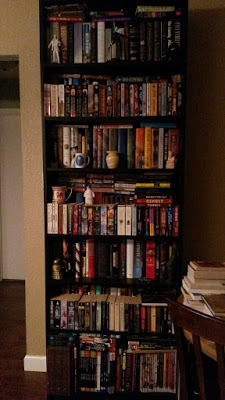
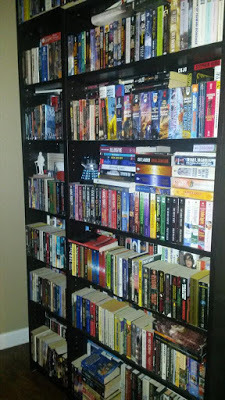
I just recently bought a house, and it's big enough that there's room for a dedicated personal library. I'm very excited! It presents a really fun challenge: how do I organize my books now that I have enough space to display all of them? (Previously, I had been just shoving a bookcase wherever it would fit and stacking books on tables. I expect I'll probably continue to do that, but the majority of my books will now fit in a single room.)
I was in library school when I first learned that some people organize their books by color. The effect is really cool, and I don't think it would be that difficult to find a particular book since I tend to remember what color my own books are. I actually have this IKEA bookshelf where I've organized a few of my books in roy g biv on their sides from top to bottom. It looks pretty neat. When I was first dating my boyfriend, he moved into a new apartment and I convinced him to let me organize his books by color because I really wanted to see what it would look like. I found out later that he hated the idea, but he let me do it anyway. (Aww.) I can definitely see the drawbacks. For example, a lot of series books wouldn't be shelved together since they each have a different cover color, like the Harry Potter books.
Aside from the IKEA shelf, my books right now (prior to moving into the new house) are organized in the standard alphabetical order by author's last name. Most of what I own is fiction, and the few nonfiction titles I have occupy a single shelf and they're not really in any particular order.
I say that my fiction is organized in alpha order, but that's true only to a certain extent. Because we have limited space in our rental, I've divided them into hardbacks and paperbacks. The hardbacks go against the back of the shelf and the paperbacks go in front of the hardbacks. Most of my shelves are deep enough that this works without any of the books hanging over the edge. In theory, this allows me to see all of my books at once. In practice, I still have to lean the paperbacks forward to see the title of the hardbacks. I hope that this won't be necessary in the new place. My graphic novels I also keep separate, and they occupy just a couple of shelves next to my cookbooks in the kitchen. (You see what I mean about putting books wherever there's space?)

When I was a kid/teen and living with my parents, I'd frequently take a couple of hours and reorganize my bookshelf in my bedroom for fun. I loved looking at all of my books and remembering a title I had forgotten I had. At the time, I had a single bookcase and it seemed like I had quite a lot of books. Teenage Kimberly would look at my current collection and feel awed. I know the trend nowadays is often to downsize material possessions, including book collections, but acquiring books has always made me feel good and I've come to like that aspect of my personality. I do have a lot of books that I haven't yet read, but the fact that they're there comforts me. I always have a book at hand, on almost any topic, whenever the itch hits me - sci fi, contemporary, romance, high fantasy, classic, middle grade, YA, adult. I strongly associate books with memories, so almost each title I pick up reminds me of something good, like the first time I attended a library conference or a particularly engaging undergrad literature class.
In my new house, I've been toying with the idea of organizing my books more like they're organized in a library. I think I want to separate my adult books from my children's and teen books, and I may even decide to separate them by genre as well. I doubt I'll go the color route, since I'll be sharing the space with my boyfriend's books (we don't interfile!) and it would look a little odd to have some shelves in the room color-coded and others not.
I thought it might be fun to take a little informal poll to see how our readers organize their personal book collections. Feel free to elaborate on your system in the comments!
Loading...







 Related StoriesGetting Things Done with Bullet Journaling
Related StoriesGetting Things Done with Bullet Journaling
Published on June 09, 2015 22:00
June 8, 2015
Audio Review: Under the Banner of Heaven by Jon Krakauer
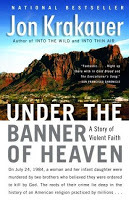 I mentioned that
Under the Banner of Heaven
was next on my list after reading a couple of memoirs by Carolyn Jessop, who escaped the FLDS. Krakauer's book focuses on the murders of Brenda Lafferty and her infant daughter Erica in 1984 by her brothers-in-law Ron and Dan Lafferty. The Lafferty brothers were not members of the FLDS, but they subscribed to many similar fundamentalist Mormon views, most notably polygamy (aka "celestial marriage"). For a period of time, they were involved with a group called the Crossfield School of Prophets, but mostly they acted separately from any recognized religion or cult. Ron soon came to believe that God told him to kill Brenda, whom he believed was responsible for his own wife leaving him.
I mentioned that
Under the Banner of Heaven
was next on my list after reading a couple of memoirs by Carolyn Jessop, who escaped the FLDS. Krakauer's book focuses on the murders of Brenda Lafferty and her infant daughter Erica in 1984 by her brothers-in-law Ron and Dan Lafferty. The Lafferty brothers were not members of the FLDS, but they subscribed to many similar fundamentalist Mormon views, most notably polygamy (aka "celestial marriage"). For a period of time, they were involved with a group called the Crossfield School of Prophets, but mostly they acted separately from any recognized religion or cult. Ron soon came to believe that God told him to kill Brenda, whom he believed was responsible for his own wife leaving him.While Krakauer's investigation of the double murder is the central part of the book, the whole scope is actually quite broad. His intention was to explore "violent faith" as it occurs in fundamentalist Mormons. He chose Mormonism for this exploration because he grew up around a large Mormon population, though he was not Mormon himself. He writes about this in the last chapter of the book, and it's strongly implied that the conclusions he draws about the origins of Mormon extremism are applicable to other faiths.
To get to those origins, Krakauer takes us on a long journey through Mormonism's history. The modern, mainstream Mormon church vociferously distances itself from people like the Laffertys and the FLDS, but the seeds of the fundamentalist sects were planted in their shared history. Krakauer writes about Joseph Smith, the Mountain Meadows massacre, Brigham Young, the many violent clashes between Mormons and non-Mormons before the trek to Utah, the introduction of polygamy to the religion and its eventual abandonment of the practice due to pressure from the federal government (and its subsequent acceptance into the mainstream American culture). He brings up the point that because Mormonism is so new and came of age in the modern era, it's subjected to a great deal of scrutiny, and its skeletons are harder to hide. Consequently, I knew about much of this before I read the book, but I still found Krakauer's exploration of the personalities behind Mormonism's founding immensely interesting. What draws me to nonfiction about cults (and religions in general) is my desire to understand what makes people believe what they do, especially when such beliefs are not widely accepted. Krakauer write at length about Smith and Young and their magnetic appeal, as well as the appeal of the messages they spread.
Krakauer also touches on a variety of Mormon fundamentalist offshoots, including the FLDS and the School of Prophets. He writes briefly about the Elizabeth Smart kidnapping as well, and his interest seems to be not just the organized Mormon fundamentalist cults like the FLDS, but also how mainstream Mormons' beliefs give way to individual fundamentalist beliefs, such as was the case with the Laffertys.
Krakauer talked at length with Ron Lafferty, who is in prison serving a life sentence (his brother Dan was executed). He's quoted in the book frequently, and his account of the murders and the "revelation" he received from God are disturbing. I normally stay away from true crime because of this, and I can't say I enjoyed the details of Ron's acts, but what he revealed to Krakauer about his thought process and the development of his religious beliefs (which have changed in radical ways since he went to prison) was fascinating. I also found myself picturing what it would be like to be in Krakauer's shoes, sitting across from Ron as he talked about his crimes.
This was published in 2003, four years before Carolyn Jessop wrote her memoir Escape . It was interesting to read the snippets of FLDS history with the knowledge of what Jessop would write about a few years later and the raid on the YFZ ranch that would soon follow. I wonder how Krakauer's own book would have changed if it were written after these events (though the FLDS is not the focus).
Krakauer narrates the book himself, and he's well-suited to it. He infuses a lot of personality into it, and he's got a few unique mannerisms that I found interesting. Often when he's quoting someone (Ron in particular, but also others not involved in violent acts, but merely witnesses to it), he'll emphasize consonants. He'll draw out the first "n" in anything and the "t" in pretty (as in "pretty much"). Sometimes it makes the dialogue come across as slightly mocking (very effective for Dan), sometimes just musical - it's got a rhythm to it that is often missing from audiobooks narrated by their authors.
If you're interested in the subject matter, I highly recommend this one.
Audiobook borrowed from my local library.







 Related StoriesAudio Review: Cleopatra's Moon by Vicky Alvear ShecterA Memoir, a Novel, and a Graphic NovelCult Memoirs
Related StoriesAudio Review: Cleopatra's Moon by Vicky Alvear ShecterA Memoir, a Novel, and a Graphic NovelCult Memoirs
Published on June 08, 2015 22:00



